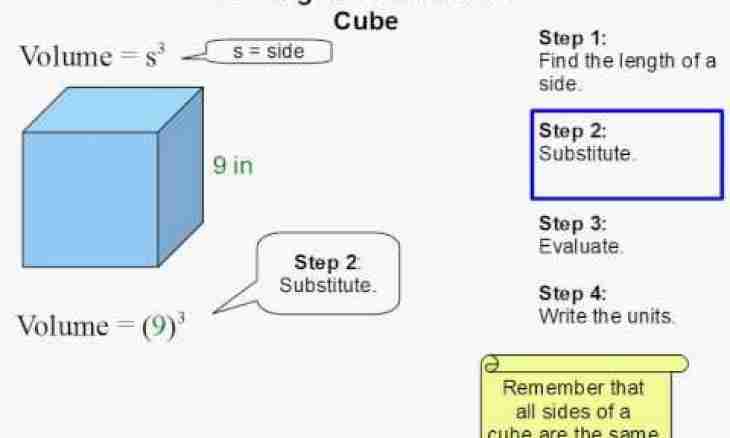There is a set of formulas for finding of volume. First of all it is necessary to define in what aggregate state there is a substance for which we look for volume. For the volume of gas some formulas, and are suitable for solution volume absolutely others.
Instruction
1. One of solution volume formulas: V = m/p, where V – the volume of solution (ml), m – the weight (g), p – density (g/ml). If it is required to find in addition weight, then it can be done, knowing a formula and amount of the necessary substance. By means of a substance formula we will find its molar weight, having put atomic masses of all elements which are its part. For example, M (AgNO3) = 108+14+16*3 = 170 g/mol. Further we find weight on a formula: m = n*M where m is weight (g), n is amount of substance (mol), M – the molar mass of substance (g/mol). It is meant that the amount of substance is given in a task.
2. The following formula for finding of volume of solution is brought out of a formula of molar concentration of solution: with = n/V, where with – molar concentration of solution (mol/l), n – amount of substance (mol), V – the volume of solution (l). We remove: V = n/c. The amount of substance can be found in addition on a formula: n = m/M where m is weight, M – molar weight.
3. Further formulas for finding of volume of gas are given. V = n*Vm, where V – the volume of gas (l), n – amount of substance (mol), Vm – the molar volume of gas (l/mol). Under normal conditions, i.e. pressure of equal 101,325 Pas and temperature 273 To the molar volume of gas is a constant and it is equal to 22.4 l/mol.
4. For a gas system there is a formula:: q(x) = V (x)/V, where q(x) (fi) – a volume fraction of a component, V (x) – the volume of a component (l), V – the volume of system (l). It is possible to bring 2 others out of this formula: V (x) = q*V and also V = V (x)/q.
5. If at a statement of the problem there is a reaction equation, it is necessary to solve a problem by means of it. From the equation it is possible to find amount of any substance, it is equal to coefficient. For example, CuO + 2HCl = CuCl2 + H2O. From here we see that in interaction 1 asking oxide of copper and 2 mol of hydrochloric acid it turned out 1 mol of chloride of copper and 1 mol of water. Knowing amount of substance of only one component of reaction on a statement of the problem, it is possible to find amounts of all substances without effort. Let, the amount of substance of oxide of copper is equal to 0.3 mol, n(HCl) = 0.6 mol, n(CuCl2) = 0.3 mol, n(H2O) = 0.3 mol means.

